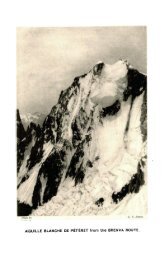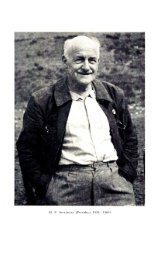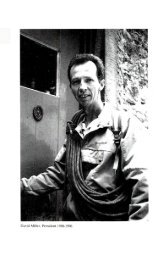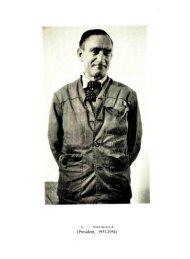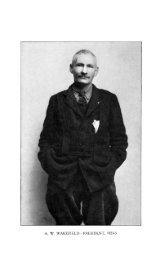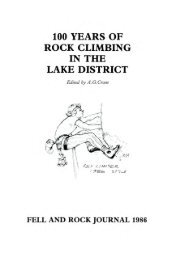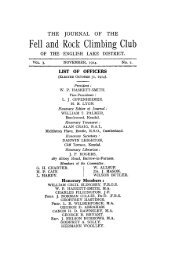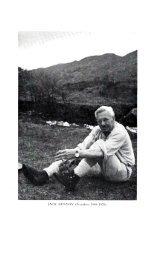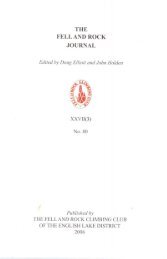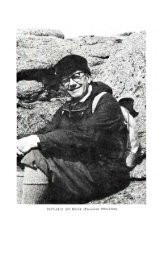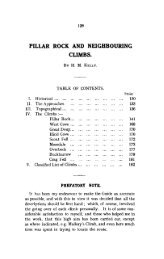Number in series 26; Year of publication 1932 - Fell and Rock ...
Number in series 26; Year of publication 1932 - Fell and Rock ...
Number in series 26; Year of publication 1932 - Fell and Rock ...
- No tags were found...
Create successful ePaper yourself
Turn your PDF publications into a flip-book with our unique Google optimized e-Paper software.
138 THE FELL AND ROCK CLIMBING CLUB JOURNALWEST BUTTRESS, SRON NA CICHE.In the l<strong>in</strong>e diagram <strong>of</strong> Sron na Ciche <strong>in</strong> the S.M.C. Guidethere are two areas untouched by l<strong>in</strong>es. The climb here describedis <strong>in</strong> that area which is bounded by the Western Gully <strong>and</strong> theWest Central Gully.The route commences at the foot <strong>of</strong> a steep slab about50 ft. to the right <strong>of</strong> the foot <strong>of</strong> W.C. Gully <strong>and</strong> just to the right<strong>of</strong> two small overhangs.The slab is climbed until lack <strong>of</strong> holds forces the climber toits left edge, a stance <strong>and</strong> belay be<strong>in</strong>g reached a little higher(90 ft.). This section can be made very difficult if the slab isadhered to as long as possible.From the platform the route lies slightly to the right; fairlyeasy climb<strong>in</strong>g leads <strong>in</strong> 140 feet to a large grass platform, situatedabove, <strong>and</strong> midway between, two conspicuous grass patches.From this po<strong>in</strong>t it should be possible to cont<strong>in</strong>ue directlyupwards, but s<strong>in</strong>ce we wished to make the climb f<strong>in</strong>ish at thehighest po<strong>in</strong>t <strong>of</strong> the Buttress we were forced to the left. Ashort upward traverse <strong>in</strong> this direction leads to a big ledge atthe foot <strong>of</strong> a steep wall. This is best climbed on the left <strong>and</strong>leads, after 50 feet <strong>of</strong> difficult climb<strong>in</strong>g, on slop<strong>in</strong>g holds, to awide dyke, which, at this po<strong>in</strong>t, traverses almost horizontallyacross the face. Above the dyke is another slab. The dyke iscrossed, <strong>and</strong> a traverse made across the slab to the left <strong>and</strong> overa low wall, a belay be<strong>in</strong>g found on a slop<strong>in</strong>g ledge low down.The position is very exposed, ly<strong>in</strong>g as it does on an overhangoverlook<strong>in</strong>g the foot <strong>of</strong> W.C. Gully. The rocks above appearrotten, <strong>and</strong> on the first ascent the outlook was not too cheerful,but a short, steep crack can be climbed without difficulty, theholds be<strong>in</strong>g actually quite reliable.The ascent <strong>of</strong> the crack <strong>and</strong> a few feet <strong>of</strong> easy rocks leads to thefoot <strong>of</strong> a very steep wall, easily identified from below by itslight colour.This wall was first attempted direct until the disappearance<strong>of</strong> all holds led to a rapid descent. The route taken lies on asteeply slop<strong>in</strong>g gangway, which appears to lead to a good stanceon the left edge <strong>of</strong> the wall. It is very difficult to effect a lodgementon the gangway, <strong>and</strong> its ascent is very difficult. At twopo<strong>in</strong>ts it is necessary to use small holds on the wall below toget round bulges, <strong>and</strong> it is very difficult to get back to the gangway.



